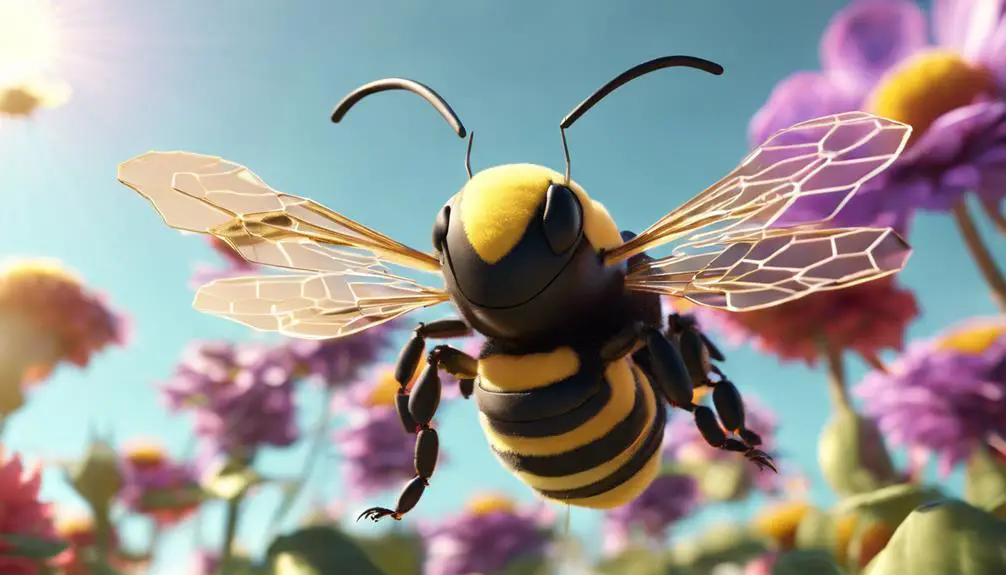Drone bees don't sting since they lack stingers altogether. Unlike worker bees, which can defend the hive and have stingers, drones are male bees focused solely on mating with the queen. This means you don't have to worry about painful encounters when you're near them. Their main role in the hive is reproduction, not protection. Drones maintain a relaxed presence, emphasizing their harmless nature. Knowing this can ease any concerns you might have about being near them. If you want to explore more fascinating facts about drone bees and their roles, there's plenty more to uncover.
Understanding Drone Bees
Drone bees are the male bees in a hive, primarily responsible for mating with a queen during the breeding season. Unlike worker bees, drones don't have stingers, so you won't have to worry about getting stung by them. They live in a world that's all about reproduction, free from the laborious tasks worker bees handle. Drones are larger than workers and sport a rounder body, allowing them to fly high and seek out a queen. Their sole purpose is to mate, and once that mission's accomplished, it's game over for them. Understanding drones helps you appreciate their unique role in the hive, reminding us that even in nature, there are different paths to freedom and purpose.
The Role of Drone Bees
In a beehive, the primary role of drone bees is to mate with the queen, ensuring the continuation of the colony's genetic lineage. Unlike worker bees, drones don't gather nectar or pollen; their sole purpose is reproduction. You might think of them as the free spirits of the hive, living without the burdens of labor. Drones are born from unfertilized eggs and usually emerge in late spring or early summer when the queen is ready to mate. During mating flights, they seek out the queen, and only the strongest drones often succeed. After mating, however, drones typically meet their end, as the hive prioritizes efficiency and survival. In this way, they contribute to the hive's legacy, embracing their role in nature's cycle.
Do Drone Bees Have Stingers?
While drones play a vital role in reproduction, they don't have stingers like worker bees do. This lack of a stinger means that you can observe these bees without fear of being stung. Drones are all about freedom and fulfilling their purpose without the defensive instincts that come with stinging. Unlike worker bees, whose primary role involves protecting the hive and gathering resources, drones focus solely on mating with queens. Their absence of a stinger allows them to carry out their duties without the burden of aggression. So, if you find yourself near a drone, you can appreciate their unique role in nature without worrying about a painful encounter. Enjoy the beauty of these fascinating creatures without concern!
Differences Between Drones and Workers
Worker bees and drones serve distinct roles within the hive, each contributing uniquely to the colony's survival and reproduction. You'll find that worker bees are the backbone of the hive, performing essential tasks, while drones have a specific purpose. Here are three key differences:
- Reproductive Role: Drones exist solely to mate with a queen, while workers focus on foraging, nursing, and hive maintenance.
- Stinging Ability: Worker bees can sting to protect the colony, but drones lack stingers and can't defend the hive.
- Lifespan: Worker bees can live several weeks to months, whereas drones typically die shortly after mating.
Understanding these roles helps you appreciate the hive's intricate dynamics and the freedom each bee enjoys within their tasks.
Behavioral Traits of Drone Bees
Drone bees exhibit unique behavioral traits that distinguish them from other hive members, primarily focusing on mating and maintaining a relaxed presence within the colony. Unlike worker bees, drones don't engage in foraging or hive maintenance; their primary role is to mate with a queen. When the time comes, drones participate in mating flights, seeking out queens in the air, which is where their instinctive drive for reproductive freedom shines through. In the hive, you'll notice drones tend to hang back, enjoying a laid-back lifestyle while workers buzz around busily. This leisurely approach allows them to conserve energy for mating, embodying a dance of nature's design, ensuring the hive's continuation while embracing their unique place in the colony.
Myths About Drone Bees
Many people mistakenly believe that drone bees can sting, which is a common myth that needs to be clarified. Drone bees, unlike worker bees, lack the necessary anatomy to deliver a sting. Understanding this can help you appreciate these fascinating creatures without fear. Here are three key points to remember:
- No Stinger: Drones don't have stingers, so they can't harm you.
- Purpose: Their main role is to mate with queens, not defend the hive.
- Gentle Nature: Drones are typically docile and pose no threat to humans.

